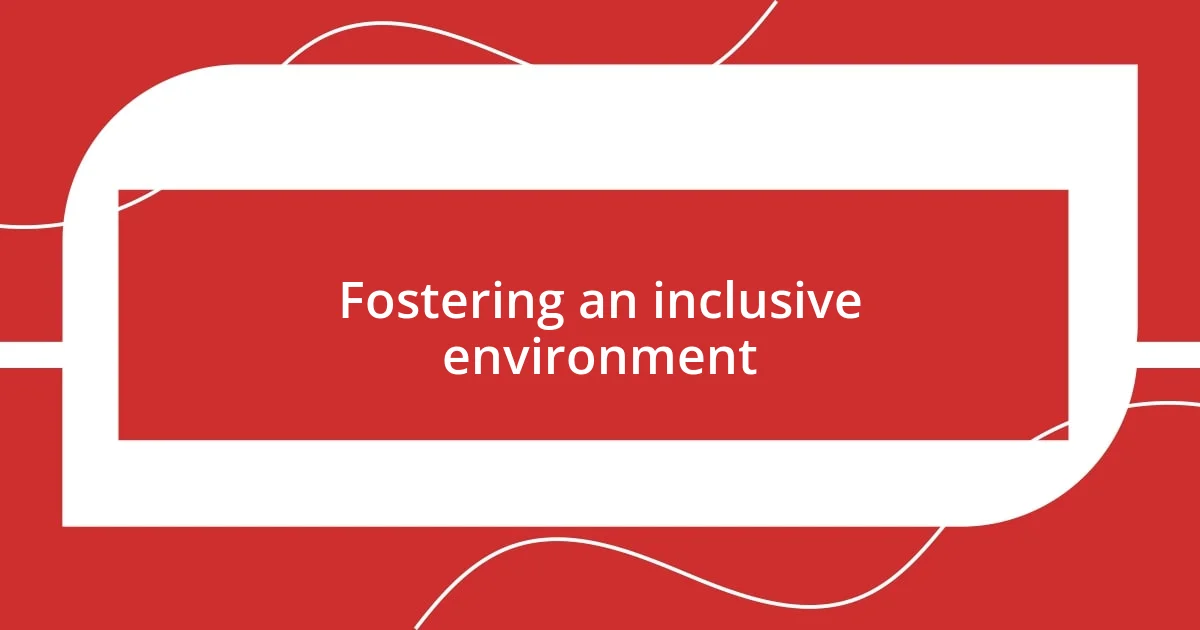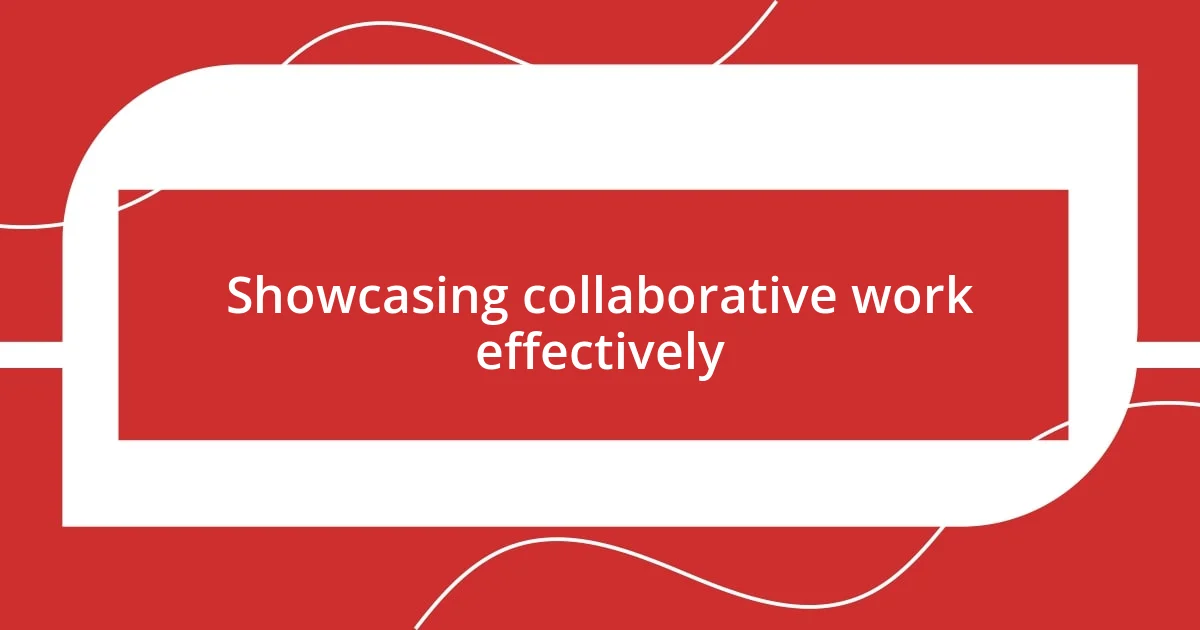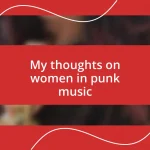Key takeaways:
- Collaboration enhances creativity by merging diverse perspectives and fostering emotional connections through shared experiences.
- Setting shared goals and establishing open communication are crucial for successful collaboration, allowing artistic visions to align and evolve.
- Creating an inclusive environment and celebrating individual contributions strengthen teamwork and enrich the collaborative process.

Understanding the importance of collaboration
Collaboration in art is a powerful catalyst for creativity. I remember a project where I teamed up with a painter. While my strength lay in writing, her visual storytelling opened up new dimensions. Have you ever experienced that moment when an idea takes on a life of its own because of a partner’s unique input? It’s exhilarating.
Working alongside female artists has taught me the value of diverse perspectives. During one particular collaboration, we fused our different styles, and the result was something I could never have created alone. It made me wonder: why do we often hesitate to seek collaboration, especially from those who may have a completely different approach?
Emotional connections deepen the significance of collaboration. In one instance, after sharing personal stories, our work took on a resonance that felt universal yet deeply intimate. It’s those shared moments of vulnerability that can elevate our art beyond mere expression—bringing real experiences to life. Isn’t it intriguing how collaboration can foster both artistic growth and deeper relationships?

Identifying and approaching female artists
Identifying female artists begins with active listening to the artistic community. I often find inspiration in social media platforms where female artists share their journeys, styles, and insights. One evening, I stumbled upon a small yet vibrant art show featuring emerging female artists. The energy in the room was palpable, filled with creativity and camaraderie. Have you ever noticed how certain spaces naturally cultivate artistic connections? It made me realize that being proactive in my search for female talent often leads to unexpected collaborations.
Approaching female artists requires sensitivity and respect for their individuality. I remember reaching out to a sculptor whose work captured my imagination. I crafted a personal message that highlighted specific pieces I admired, which resulted in a thoughtful conversation. This experience taught me that authenticity is key. Have you ever felt unsure about reaching out to someone because of their work? I learned that expressing genuine appreciation often breaks the ice and paves the way for collaboration.
Hosting community events or workshops focused on female artists can also be a powerful approach. I once organized a local meetup that featured discussions on the unique challenges female artists face, which opened my eyes to different perspectives. The stories shared that evening fostered a deeper understanding and connection among all participants. Does this approach resonate with you? In my experience, creating safe spaces for dialogue not only supports artists but can also lead to fruitful collaborations.
| Identifying Female Artists | Approaching Female Artists |
|---|---|
| Active listening in art communities | Authenticity in outreach |
| Engagement through social media | Personalized communication |
| Attending art shows | Expressing genuine appreciation |
| Hosting community events | Creating safe spaces for dialogue |

Setting shared goals for projects
Setting shared goals in collaborative projects can truly enhance the experience and outcome. I recall a time when I partnered with a fellow artist to create a multimedia installation. We sat down over coffee, allowing our ideas to flow freely while we outlined our vision. This initial conversation enabled us to identify what we each wanted to achieve, leading to a deeper commitment to our shared objectives. Sharing aspirations not only aligned our efforts but also fostered a sense of camaraderie.
To set effective shared goals, consider the following steps:
- Open Dialogue: Start with a candid conversation about your individual visions and how they can intertwine.
- Define Outcomes: Discuss specific outcomes you both hope to achieve, such as audience engagement or artistic exploration.
- Establish Milestones: Break down the project into manageable phases or milestones to maintain focus and motivation.
- Be Flexible: Allow room for adjustments as the project evolves and new ideas emerge, staying open to shifting dynamics.
- Celebrate Achievements: Acknowledge and celebrate small victories to reinforce mutual support and enhance teamwork.
Through experiences like these, I’ve learned that setting common goals is just as much about the journey as it is about the destination. It can be a delightful way to cultivate mutual respect and friendship, making the creative process even more rewarding.

Navigating creative differences successfully
Navigating creative differences can be challenging, but I’ve found that embracing open communication makes all the difference. I once collaborated with a talented painter who had a very different approach from mine. Instead of insisting on my vision, I suggested we explore each other’s perspectives during our brainstorming sessions. This willingness to listen not only enriched our project but also deepened my respect for her artistic process. Have you ever found common ground in unexpected conversations?
In my experience, finding ways to compromise is essential. There was a time when my partner and I faced a disagreement over color palettes for a shared installation. Rather than forcing a solution, we took a step back and experimented with different hues on a digital platform. This playful approach transformed our conflict into a shared discovery, teaching me that creativity often thrives in the space between ideas. Isn’t it fascinating how a simple shift in perspective can turn a standoff into a collaboration?
Additionally, I’ve learned that celebrating each other’s contributions can foster a more positive environment. After completing a successful project with a fellow artist, we took time to acknowledge our unique strengths. That moment of recognition not only felt rewarding but also reinforced our commitment to creating together in the future. Isn’t it true that appreciation can turn a good collaboration into something truly extraordinary?

Fostering an inclusive environment
Creating an inclusive environment is essential for fostering collaboration, especially when working with female artists. I remember a project where we made a conscious effort to create a welcoming space by inviting everyone to voice their opinions during our planning sessions. This was more than just a formal roundtable; it became a genuine exchange where ideas flowed freely and everyone felt heard. Have you ever noticed how empowering it feels to be included in the decision-making process? It’s transformative, and I believe it can spark innovation.
I also discovered that simple gestures, like establishing a code of conduct, can go a long way in promoting respect among artists. During one collaboration, we laid out guidelines that emphasized the importance of kindness and constructive feedback. Knowing we had a mutual agreement created a sense of security, allowing us to explore bold ideas without fear of judgment. Have you ever felt that sense of safety fuel your creativity? That’s exactly what it did for us.
Furthermore, I learned that representation matters deeply in collaborative projects. I once took part in an exhibition where we made it a point to feature diverse voices, which energized the entire creative process. Each artist brought unique perspectives, and that richness cultivated an inclusive atmosphere that inspired us all to push our boundaries. It made me wonder—how much could we achieve if we actively seek out and involve different backgrounds in our creative endeavors? The possibilities are endless!

Showcasing collaborative work effectively
Showcasing collaborative work effectively requires strategic presentation to highlight the strengths of each artist involved. In one of my exhibitions, we created a joint portfolio that paired photos of our individual contributions with commentary from each participant. This approach not only showcased our unique styles but also wove a narrative that celebrated our collective journey. Have you ever felt the power of storytelling in understanding complex collaborations?
I’ve found that utilizing digital platforms can significantly broaden the reach of our collaborative efforts. Last year, my team and I created a virtual gallery showcasing our joint artwork. By incorporating video interviews where each artist discussed their piece, we invited viewers into our creative process. This personal touch fostered a deeper connection with our audience, and it felt rewarding to share the behind-the-scenes experience. How do you think technology could further enhance artistic collaboration?
Another effective strategy is to curate events that make the collaboration accessible and engaging. For instance, I organized a live Q&A session following the unveiling of a joint art installation, allowing our audience to ask questions directly about our creative decisions. This interaction not only educated our viewers but also reinforced the collaborative spirit at the heart of the project. Have you noticed how direct engagement can transform passive spectators into active participants? In my experience, it elevates the entire collaborative narrative.

Reflecting on lessons learned
Reflecting on my experiences collaborating with female artists, I’ve come to realize that vulnerability can be a profound teacher. In one project, we shared our struggles and insecurities, which created a space for authentic connection. I often wondered, how often do we use our vulnerabilities as tools for growth? The openness brought us closer, allowing for creative breakthroughs that might have remained dormant otherwise.
One significant lesson I learned is the importance of patience. During a particularly intense collaboration, there were moments when disagreements arose, leading to frustration. However, those times taught me that taking a step back and allowing each artist’s voice to be heard can lead to richer outcomes. Have you ever found that allowing space for tension can ultimately enhance the creative process? I’ve seen it firsthand, and it’s a reminder that art is not just about the end product but also about the journey we take together.
Moreover, the process of celebrating milestones together has proven invaluable. In one experience, we dedicated time to recognize our individual contributions after completing a major piece. It was more than just praise; it fostered a sense of unity and shared accomplishment. This made me ask, how often do we pause to appreciate what we’ve created as a team? Those moments of gratitude solidified our bond and enriched our collaborative spirit, reflecting how teamwork goes beyond mere task completion.













